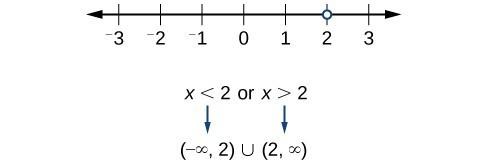Domain Restrictions
Learning Outcomes
- Find the domain of a function algebraically
- You cannot divide by [latex]0[/latex].
- You cannot take the square (or other even) root of a negative number, as the result will not be a real number.
- A rational function where the denominator could potentially become [latex]0[/latex] for some value or values of x. An example of this is [latex]f\left(x\right)=\dfrac{x+1}{2-x}[/latex] is a rational function.
- A radical function with an even index (such as a square root), where the radicand (quantity under the radical) could potentially be negative for some value or values of x. [latex]f\left(x\right)=\sqrt{7-x}[/latex] is a radical function.
| Function | Restrictions to the Domain |
|---|---|
| [latex] f(x)=\dfrac{1}{x}[/latex] | If [latex]x=0[/latex], you would be dividing by [latex]0[/latex], so [latex]x\neq0[/latex]. |
| [latex] f(x)=\dfrac{2+x}{x-3}[/latex] | If [latex]x=3[/latex], you would be dividing by [latex]0[/latex], so [latex]x\neq3[/latex]. |
| [latex] f(x)=\dfrac{2(x-1)}{x-1}[/latex] | Although you can simplify this function to [latex]f(x)=2[/latex], when [latex]x=1[/latex], the original function would include division by [latex]0[/latex], so [latex]x\neq1[/latex]. |
| [latex] f(x)=\dfrac{x+1}{{{x}^{2}}-1}[/latex] | Both [latex]x=1[/latex] and [latex]x=−1[/latex] would make the denominator 0. Again, this function can be simplified to [latex] f(x)=\dfrac{1}{x-1}[/latex], but when [latex]x=1[/latex] or [latex]x=−1[/latex], the original function would include division by 0, so [latex]x\neq1[/latex] and [latex]x\neq−1[/latex]. |
| [latex] f(x)=\dfrac{2(x-1)}{{{x}^{2}}+1}[/latex] | This is an example with no domain restrictions, even though there is a variable in the denominator. Since [latex]x^{2}\geq0,x^{2}+1[/latex] can never be [latex]0[/latex]. The least it can be is [latex]1[/latex], so there is no danger of division by [latex]0[/latex]. |
| Function | Restrictions to the Domain |
|---|---|
| [latex] f(x)=\sqrt{x}[/latex] | If [latex]x<0[/latex], you would be taking the square root of a negative number, so [latex]x\geq0[/latex]. |
| [latex] f(x)=\sqrt{x+10}[/latex] | If [latex]x<−10[/latex], you would be taking the square root of a negative number, so [latex]x\geq−10[/latex]. |
| [latex] f(x)=\sqrt{-x}[/latex] | When is [latex]-x[/latex] negative? Only when x is positive. (For example, if [latex]x=1[/latex], then [latex]−x=-1[/latex]. But if [latex]x=-3[/latex], then [latex]−x=3[/latex]. This means [latex]x\leq0[/latex]. |
| [latex] f(x)=\sqrt{{{x}^{2}}-1}[/latex] | [latex]x^{2}–1[/latex] must be positive, [latex]x^{2}–1>0[/latex]. So [latex]x^{2}>1[/latex]. This happens only when x is greater than 1 or less than [latex]−1[/latex]: [latex]x\leq−1[/latex] or [latex]x\geq1[/latex]. |
| [latex] f(x)=\sqrt{{{x}^{2}}+10}[/latex] | There are no domain restrictions even though there is a variable under the radical. Since [latex]x^{2}\ge0[/latex], [latex]x^{2}+10[/latex] can never be negative. The least it can be is [latex]\sqrt{10}[/latex], so there is no danger of taking the square root of a negative number. |
How To: Given a function written in equation form, find the domain
- Identify the input values.
- Identify any restrictions on the input and exclude those values from the domain.
- If there is a denominator in the function’s formula, exclude any real numbers that cause the denominator to be equal to zero. To do this, set the denominator equal to zero and solve for [latex]x[/latex] .
- If the function’s formula contains an even root, exclude any real numbers that result in a negative number in the radicand. To do this, set the radicand greater than or equal to [latex]0[/latex] and then solve.
- Write the domain in interval form, making sure to exclude any restricted values from the domain.
Example
Find the domain of the function [latex]f\left(x\right)={x}^{2}-1[/latex].Answer: The input value, shown by the variable [latex]x[/latex] in the equation, is squared and then the result is lowered by one. Any real number may be squared and then be lowered by one, so there are no restrictions on the domain of this function. The domain is the set of real numbers. In interval form, the domain of [latex]f[/latex] is [latex]\left(-\infty ,\infty \right)[/latex].
Example
Find the domain of the function [latex]f\left(x\right)=\dfrac{x+1}{2-x}[/latex].Answer: When there is a denominator, we want to include only values of the input that do not cause the denominator to be zero. So, we will set the denominator equal to 0 and solve for [latex]x[/latex].
[latex]2-x=0[/latex]
[latex]-x=-2[/latex]
[latex]x=2[/latex]
Now, we will exclude [latex]2[/latex] from the domain. The answers are all real numbers where [latex]x<2[/latex] or [latex]x>2[/latex]. We can use a symbol known as the union, [latex]\cup [/latex], to combine the two sets. In interval notation, we write the solution: [latex]\left(\mathrm{-\infty },2\right)\cup \left(2,\infty \right)[/latex]. In interval form, the domain of [latex]f[/latex] is [latex]\left(-\infty ,2\right)\cup \left(2,\infty \right)[/latex].
In interval form, the domain of [latex]f[/latex] is [latex]\left(-\infty ,2\right)\cup \left(2,\infty \right)[/latex].
Example
Find the domain of the function [latex]f\left(x\right)=\sqrt{7-x}[/latex].Answer: When there is an even root in the formula, we exclude any real numbers that result in a negative number in the radicand. Set the radicand greater than or equal to zero and solve for [latex]x[/latex].
[latex]7-x\ge 0[/latex]
[latex]-x\ge -7[/latex]
[latex]x\le 7[/latex]
Now, we will exclude any number greater than 7 from the domain. The answers are all real numbers less than or equal to [latex]7[/latex], or [latex]\left(-\infty ,7\right][/latex].Contribute!
Licenses & Attributions
CC licensed content, Shared previously
- College Algebra. Provided by: OpenStax Authored by: Jay Abramson, et al.. Located at: https://openstax.org/books/precalculus/pages/1-introduction-to-functions. License: CC BY: Attribution. License terms: Download for Free at: http://cnx.org/contents/[email protected].
